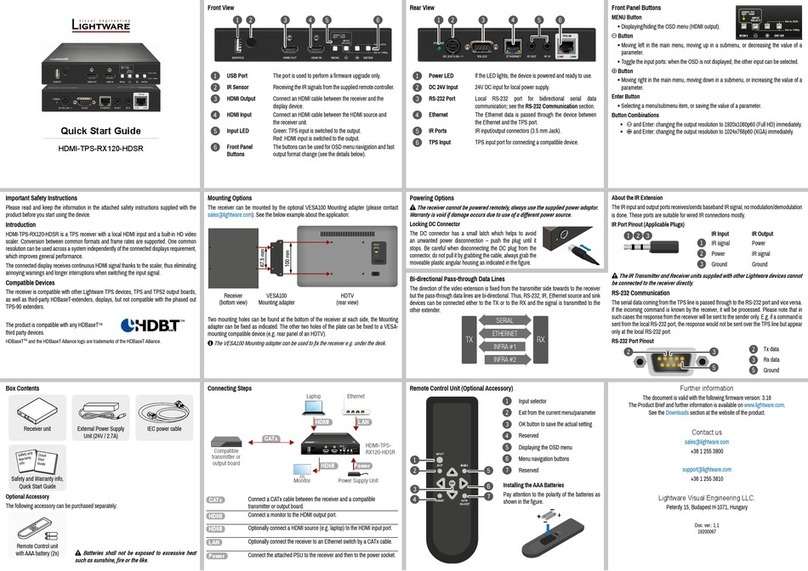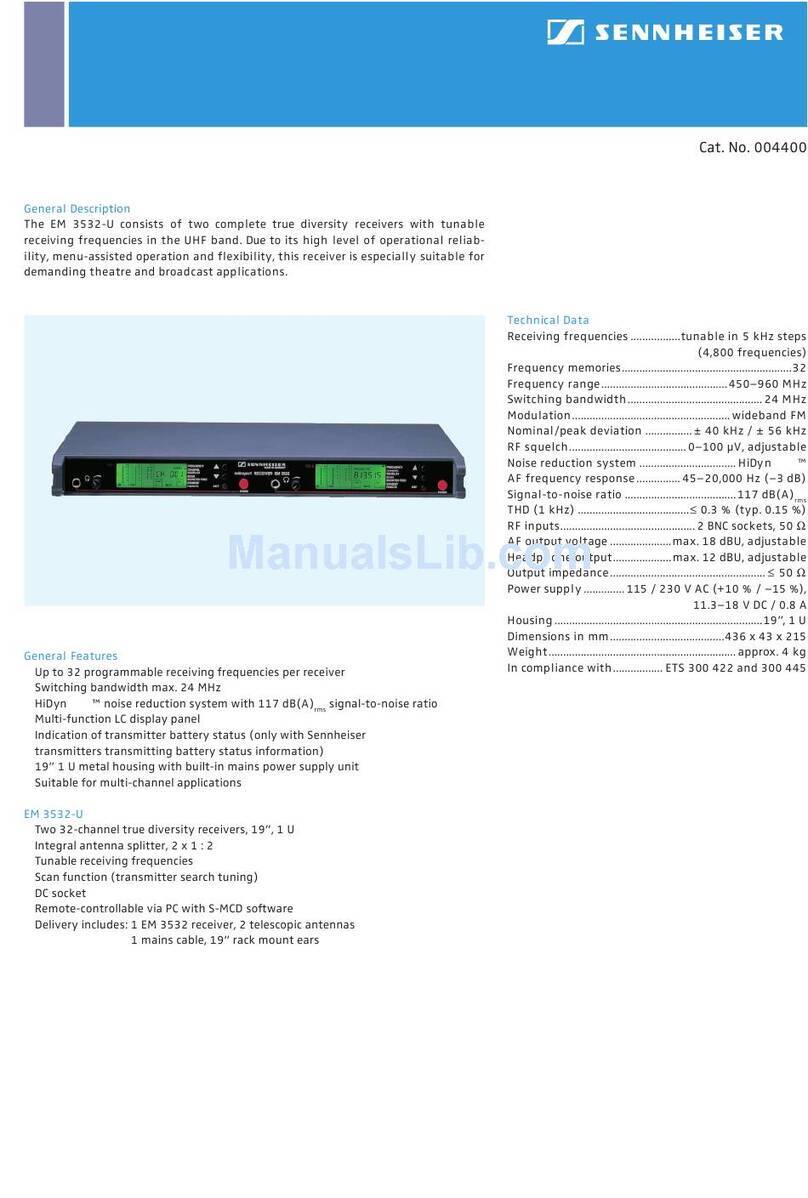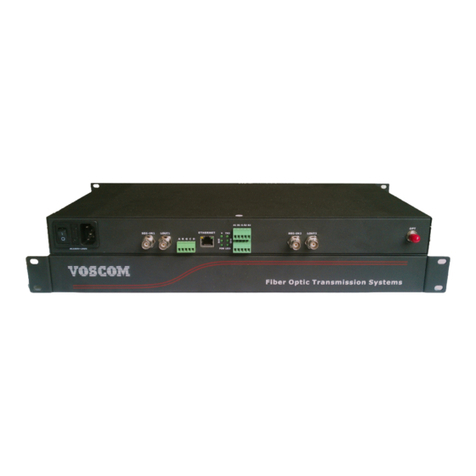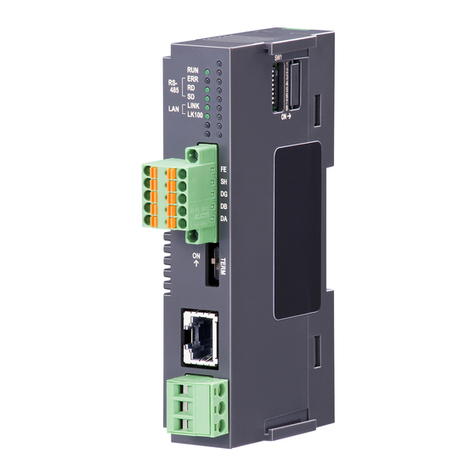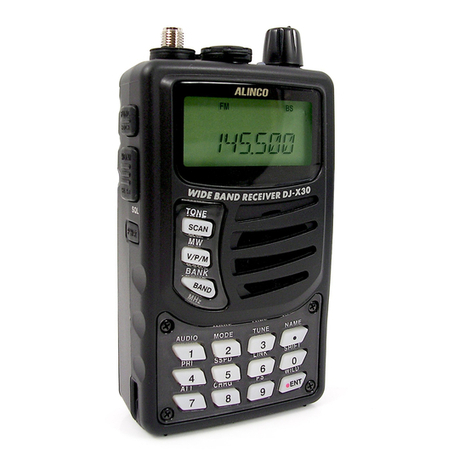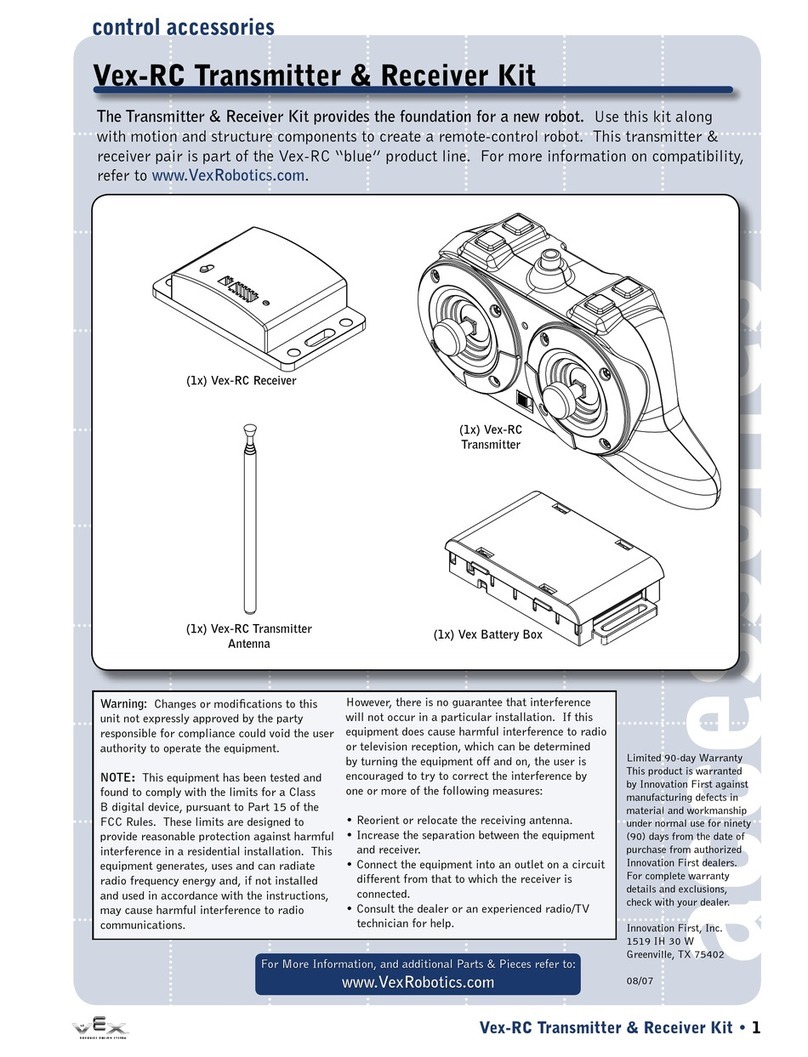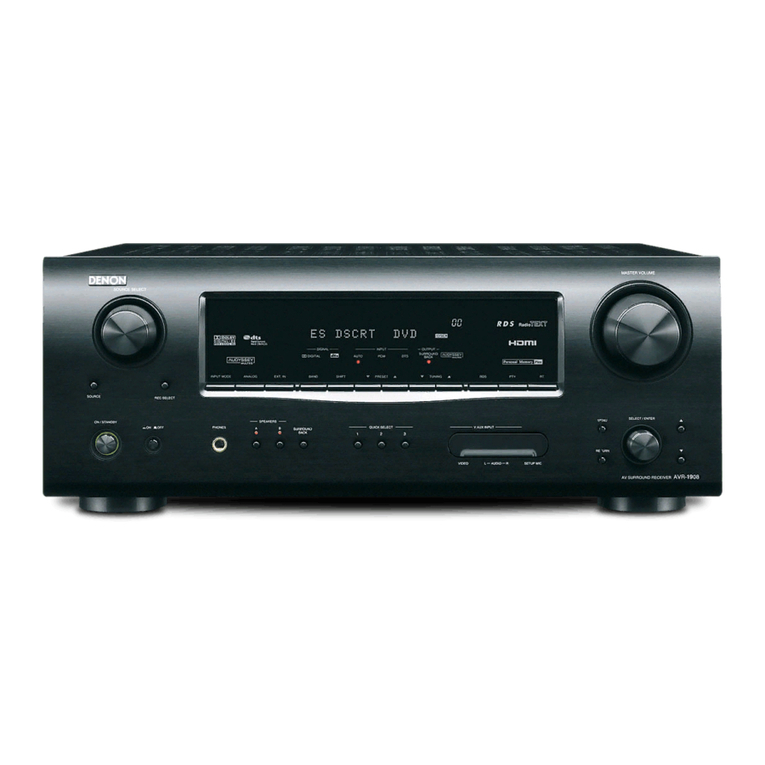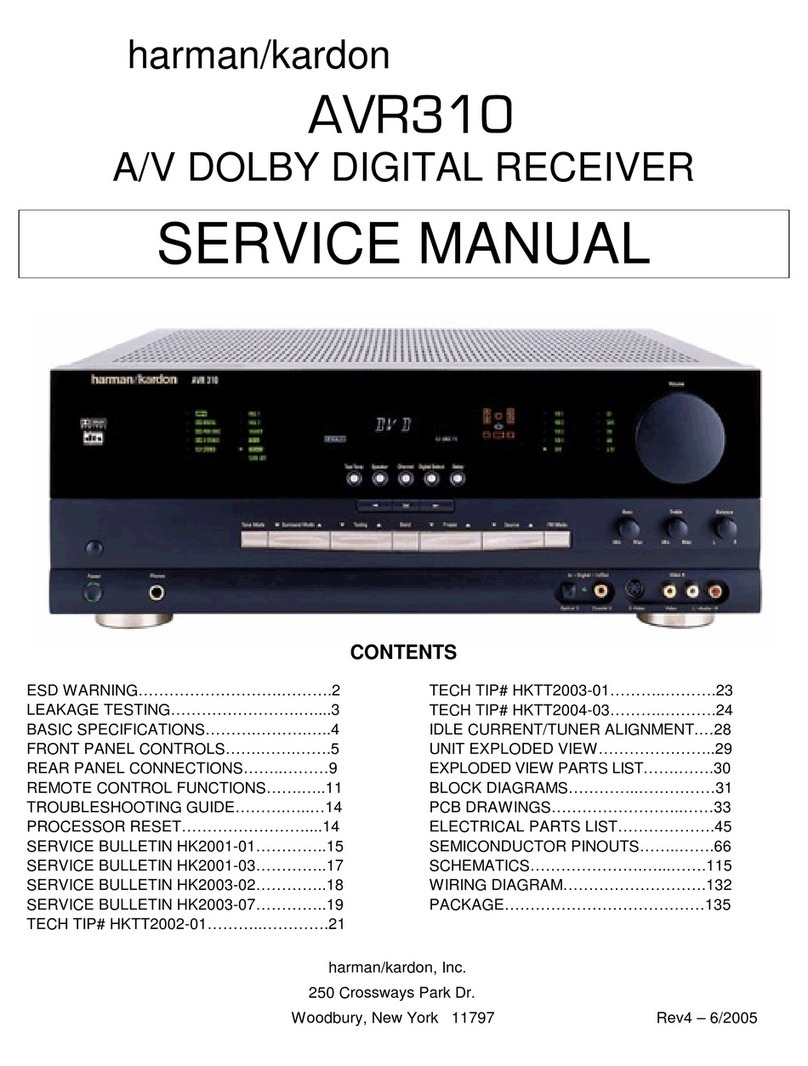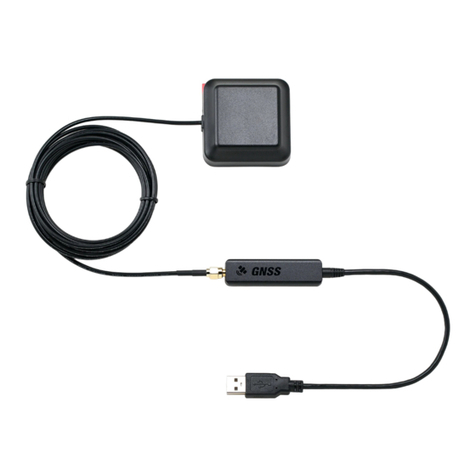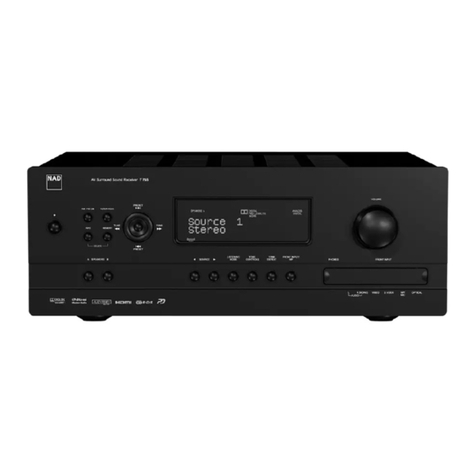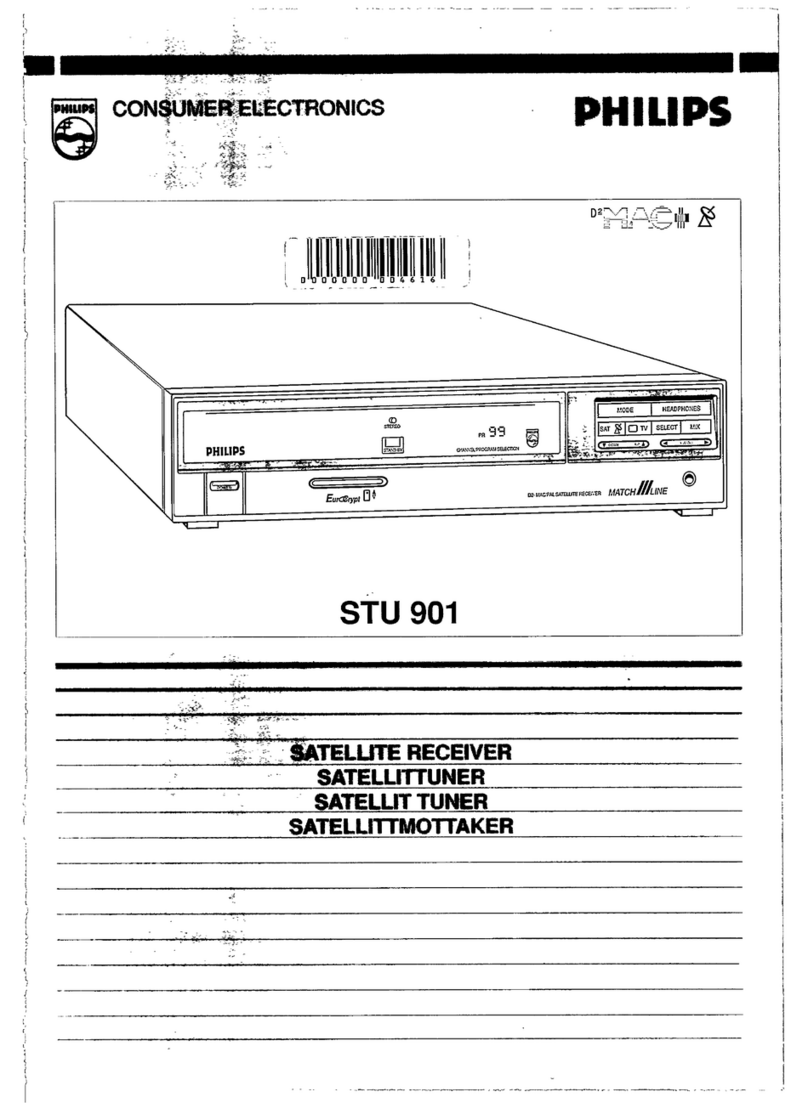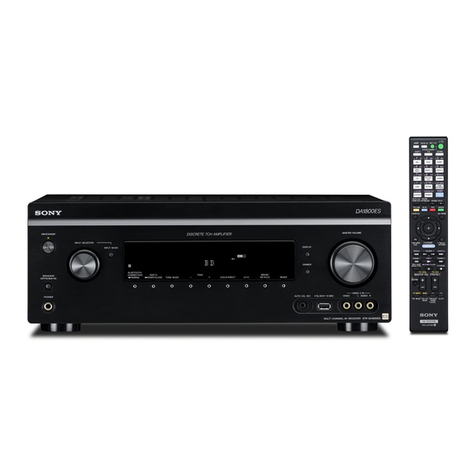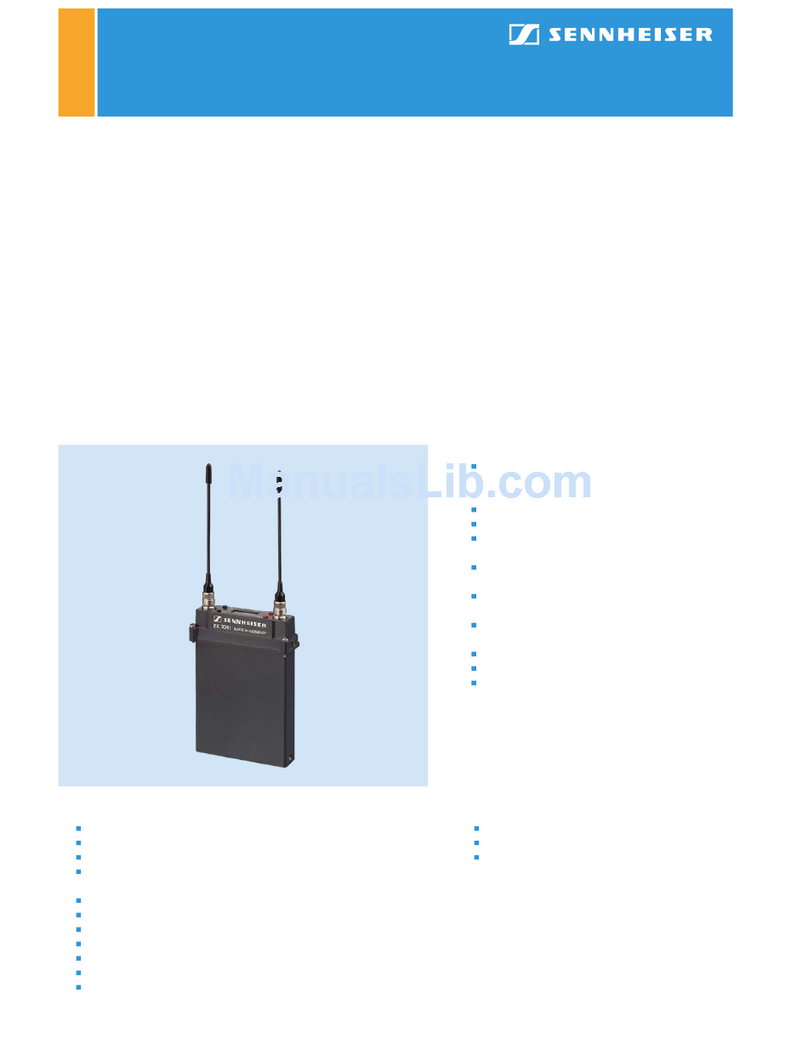Audiotel International Scanlock ECM User manual

Audiotel International Ltd
Scanlock ECM
Operators Manual
Audiotel International Ltd
Cavendish Courtyard
Sallow Road
Weldon
Corby
NN17 1DZ
England
Tel (0)536 66677
Tlx 341775AUDINTG
Fax (0)536 66711
Copyright 1991 Audiotel International Ltd. The contents of this publication may
not be reproduced in any manner or form without the permission of Audiotel
International Ltd.
April 1991
Scanlock ECM Operating Manual Issue 3.4

Contents
Introduction 1
Other Applications 1
Guarantee 1
Sen/icing 2
Training Transmitters 2
Preparation for Use 3
Unpacking 3
Operating Environment 3
Storage and Shipment ■»3
Accessories 3
AC Operation 4
AC Voltage Selection 4
Power Cable 4
Battery Power Supply 4
Charging 4
Switching On 4
Getting To Know Your Scanlock ECM 5
Summary of Controls, Indicators and Outputs 11
Front Panel
1 0 M H z + I n p u t 1 1
SSS (Strong Signal Seeking) 11
R F ( 1 0 M H z + ) 1 1
A M H
F M H
Signal Strength Display 11;
Locate 1'
Reset H
Fine ■12
Upper (Squelch) 12
Squelch Indicator 12
Volume 12
AC Indicator 12
Headphones Output 12
Lower (Squelch) 12
Tune 12
Mode 12
Manual 12
LCD 12
SC 13
Lock 13
CF 13
Scan 13
10MHz- 13
Scanlock ECM Operating Manual Issue 3.4

Rear Panel
Remote Alarm 13
10.7 MHz Out 13
2 M H z O u t 1 3
lOMHzOut 13
Recorder 13
DC Out 13
Squelch 13
Power Selection 13
Conducting a Sweep 14
Search Procedure Basics 14
Detection 14
Verification I4
Location ]4
Methods of Conducting a Sweep 14
Detection 14
Verification ■15
Location '*
Set-up & Configuration Modes 17
01 RFSSSFM 17
02RFSCANFM ■I7
0 3 C F S C A N F M ■I7
0 4 M C S C A N F M 1 7
0 5 R F S S S L O C K ] 7
0 6 R F S C A N L O C K ] 7
0 7 C F S C A N L O C K I 7
0 8 M C S C A N L O C K I 7
09 step size adjustment 17
10 RF min adjustment I8
11 RF Max adjustment 18
12 CF min adjustment I8
13 CF max adjustment I8
14 Battery Condition • 13
Practice of Conducting a Sweep 19
Recognition of the Presence of a Signal 19
Correlation Techniques 19
Detection and Verification 20
RF SSS Sweep for Radio Devices 20
RF or CF SCAN Sweep for Radio Devices 20
Location 21
MC Sweep 21
Mains Cables 21
Other Cables 22
Location 23
Scanlock ECM Operating Manual Issue 3.4

Frequency Measurement 24
Measuring the frequency of a signal 24
SSS Mode 24
SCAN Mode 24
Use of Squelch Controls 25
LOWER 25
UPPER 25
Checking Telephone Cables for Radio Devices 26
Continuous Protection Against Eavesdropping
Devices 27
Introduction 27
SCAN Check 27
SSS Check 27
Figure A 28
FIGURE B 29
FIGURE C 30
Scanlock ECM Operating Manual Issue 3.4

Introduction
Scanlock ECM is a radio recerver designed for rapid detection, identification and location of
hidden transmitters used for eavesdropping purposes.
Scanlock's advantage over conventional counter - surveillance equipment lies ir> its ability to
Scanlock continues to search for any new, stronger signal.
SuoDOse a low-powered transmitter is concealed at one end of a room. If Scanlock is located
anne other enS^en at that posrrion the strongest signal may be due to a local radicrstation.
^t^S^SS^^ transmission will be heard. As Scanlock is moved about the room a
oosmon Son be reached where the strength of the low-powered transmitter ,s greater than
+Ph°? °° ™It radio Son due to the now diminished distance between Scanlock and the
co^ceaTec^SS£^^^^ tune automatically to this signal and the transmitter
wTbe heard Scanlock's facilities enable the operator to confirm the presence of an eaves
dropping transmitter and to physically locate it with ease.
It is this combination of Scanlock's fast automatic tuning and the fact that it can be moved
during the aromatic tuning operation to minimise the distance between It and any concealed
transmitter that makes Scanlock highly effective and easy to operate.
SnScSv S too smdlt S« pSonTbe gdned through automatic operation
o°r Fothes'e sLa°on™canlock-s SCAN mode is used. Due to Scanlock's "Phrtcrtjd send
PP„ the VAN ooeration is very quick. The extra sensrtMty gained through SCAN control
oTeSc, tn^ * S*rac«cal7o?nitially move Scanicck around the area under search
during this operation.
In add-on to detecting, identifying and locating conventional transmitters, that is, those which
raSate the r signals through an antenna into the surrounding space, Scanlock can detect
SscSe? or current carrier' devices and other low frequency transmtfters that transmrt
aTonq a paif of AC power cables (from which they normally draw their power) or other cable
Sin oreference to the surrounding space. The eavesdroppers receiver is connected at a
^o^T^bc^q. Generally, receivers to detect such transmitters are available only
separately and may be expensive.
Other Applications
EavesdroDDinq transmitters are not only used to eavesdrop on conversation, they can be used
tc> checS^property is empty and therefore unguarded. Illegal entries into property us,ng this
technique to reduce risk have been reported in the national press.
Tracking transmitters attached to vehicles can be detected, identtfied and located using
Scanlock.
Guarantee
The equipment is guaranteed for a period of two years from the dote of original Purchase.
Plea!e referto our Standard Terms and Condrfions relating to claims under guarantee and
return of equipment. These qre available on request.
Scanlock ECM Operating Manual Issue 3.4

Servicing
Equipment should be returned to Audiotel in the event of any need for servicing or repair. If this
is impractical the servicing should only be carried out by quqlified personnel. Servicing by the
customer or his ogent during the guqrantee period moy invqlidqte the guqrqntee.
Training Transmitters
A conventionol transmitter together with o mqins carrier transmitter are invaluable aids in gain
ing familiarity with the operation.
Suitable transmitters are available for this purpose from Audiotel. The purchaser must check with
the local Wireless licensing department as to the legality of operating such transmitters.
Scanlock ECM Operating Manual Issue 3.4

Preparation for Use
Unpacking
The shipping container should be inspected for any damage. If there is evidence of damage
this should be retained until the equipment is checked end ell qccessories occounted for. This
will ossist in any claims of damage due to transit.
Operating Environment
The operating environment should be within the following limits:
Temperature + 5 deg C to + 40 deg C
Humidity Less than 95% relative, non-condensing
Storage and Shipment
When not in use the unit should be stored in a clean, dry environment. The permissible storage
temperature range is 0 deg C to + 55 deg C
The original packing should be retained in case the unit needs to be returned to Audiotel. Be
fore despatch of any equipment to Audiotel the Soles department must be contacted. The
address, telephone, telex and fax numbers are listed at the front of this manual. If the original
packing material is not available then a sturdy air-freight quqlity carton together with generous
cushioning material must be used. The carton should be marked clearly with the destination
and customer's name. 'FRAGILE' labels or markings should be attached.
Accessories
Scanlock ECM Is provided with the following occessories. These should be checked on
unpocking.
refer to figure A
Accessory Item Qucntity
HF Antenna A
LF Antenna B
HF Antenna Lead C
BNC Lead D
Remote Alarm E
Remote Alarm Lead F
Head-phones G
Scanlock ECM Operating Manual Issue 3.4

Power Lead H
Low Frequency Interfqce j
Telephone Interfoce K
Telephone Interfoce Lead L
Telephone Interface Antenna Lead M
Attache Case
BNC - Crocodile Clip Lead P
Right Angle N Connector R
Any shortages must be notified at once
AC Operation
For re-charging the battery pack or for AC operation Scanlock ECM requires q power source of
110/120 or 220/240 VAC, 48-60 Hz. single phose.
AC Voltage Selection
(Refer to figure B). Voltage selection is made by the rear panel switch (8). For selection of 220/
240V operation slide switch such that 230V is visible.
Power Cable
A three-wire power cable is supplied in accordance with international safety standards. When
correctly connected this grounds the chassis of the unit. To avoid the possibility of injury or
death, the chassis, via the cable supplied, must be grounded before AC power is supplied. Any
extension cable or isolating transformer supply must provide a suitable earth connection.
Power cable connections are as follows:
Brown =Live
Blue =Neutral
Yellow/Green =Earth or Ground
Battery Power Supply
The internal batteries in the unit will give 8 hours operation.
Charging
When the power lead (H) is connected the battery will automatically charge. If the unit is
switched off the unit will automatically fast charge until clmost fully charged and then switch
into trickle charge mode.
For full capacity it is recommended that the unit is left charging overnight.
Switching On
The on-off switch is located on the right hand side of the unit above the power connector.
Scanlock ECM Operating Manual Issue 3.4

Getting To Know Your Scanlock ECM
In order to familiarise yourself with the setting up and operation of Scanlock ECM follow the
directions in bold type which will take you through the controls used to enter the various set-up
and configuration modes. This section will not attempt to enter all modes, as access to all con
figuration modes is identical as are access to all operating modes are fundamentally similar.
What the section aims to show, in a concise form, the methods of accessing the various modes.
When the Scanlock ECM is switched on it will perform a self test / initialisation sequence which
tckes qbout 5 seconds. Immediotely prior to completing this sequence it will ccrry out a battery
test and display the condition for about 3 seconds.
Switch Scanlock ECM on.
The front panel display will be as figure 1.
mat ^3<3m
oil
■. ■' ■:■:.■■:07.L
CD @
;.;llLxxllli
■■■•■:-;.:S:::v;.?^.ss:«;::-sw:;
CD©
SCAU
cT
CD1®
W333a3p§
CD©
itiiiii
SSBSSiSSSJBg
USB
CD®
373333
0 I ; ■. : - -
.-:•;•:-.- ■■... :•: ■:.■■.. .-. ■.■■.■.■■,■■■■.. ■..;.....;.■■■■■
:33B03J7-::
PP30.
.
373337
id
33073/3:
311
llllll
MJN»S««»X»-S««S«»«>»!»«^c«S«S^!^^ "W««SK9«SSK*Ka««N^«»!««^^
Figure 1
The numbers along the bottom line of the display represent hours.
The marker above the hours indicates the number of hours use before the Scanlock ECM needs
to be charged.
eg in figure 1 the Scanlock ECM has approximately 6 hours use before its batteries need to be
charged.
During use, when the battery capacity falls below 1 hour, then the message —LOW BATTERY—
will be displayed at regular intervals.
The battery condition may be checked at any time during use by selecting configure mode 14.
(see Set up and Configure Modes)
Scanlock ECM Operating Manual Issue 3.4

After the initialisation process the Scanlock ECM will enter the OPERATING MODES menu as figure
2 with the MODE led illuminated.
CZ 6 ?
PP0PPP07ppp00mPPPPPPPPPP0P7P07
.:. ■:: ■■■■.■■■:■. ■.... ■.■.■■.■■.■■ ■■■■■. ; ■; ■;■;;■■.■;■■..: ■:■::■■:■:■:■:■:■:■:■■:
■■■■■■■'■Z-. ■.: ■.:: ■.
PpP":7P7P0PP:::"PP
■:■:■:: : ; ■.:.: ■■::■'.' ■. ■:; : ■.. ■. :; '. ■'■':.;
:"■.■:■■■.: :.;.'. ■■'.■'■:■'■' ■: ■■..'..■■'■'■.
.....0,M3m:^333m^
■.■;: :: ■■■.:.: ■.■:■:■■ ■■■■■■■. ■■■■■.■..■;■■■■ ■■.■■■■.■■■.■■■■■:■■■.■.■.■.■.. ■.. ■■.■■.■■
CD © CD ® SCANLOCK ECM
Operating Modes
"TUNE" selects
Srrrn
::PA:P-P
FteSET
v / - < * ■
LOCATfi -
( ) 0
WmmTMJJP.
( ) O
Figure 2
There are two menus available, the OPERATING MODES which allow the user fast access into
operating modes and the CONFIGURATION MODES menu which allow the user to set specific
parameters for a sweep.
Rotating the TUNE control anti-clockwise toggles between these two menus.
Rotating the TUNE control clockwise from the OPERATING MODES menu steps through the oper
ating modes.
Rotating the TUNE control clockwise from the CONFIGURATION MODES menu steps through
configuration modes.
We will first enter a set up mode.
Select OPERATING MODES and rotate the TUNE one step clockwise.
The Scanlock ECM should be as Figure 3
Scanlock ECM Operating Manual Issue 3.4

■--- '■■' '---'■:-, " '■'•■
CZ
RF
■■'■"■■:: ■';■■■;-" ■■■;■.;-.: ■: ■'. ■■'. ■■'. ■■", ■■:■■/. ■
303333
SCAN
tiiiiii
WZD j >
llttllll
CD
FM
1:111111
CD®
777M'
01 RF SSS FM
"MODE" selects
L:::'■■■::■' :'. X<X 'mm*
CM
'. ' "• ' ■■■■::,:,.
X);:: :
RESET
. @
l;:x
) &
|iI|||;|:;Lil
I)
(i00€
^^^^^^^^^^^^^^^^^^^^^'1 ■ "'7^^^^^^^^^^^^^»^^M
Figure 3
If you wish to select this mode press the MODE button.
If you have inadvertently entered mode selection pressing the RESET button will allow you to
revert to the operational setup without making any changes.
Turn TUNE control one step clockwise to mode 02 (RF SCAN FM) and press MODE button.
Display should be as Figure 4 with the RF, SCAN and FM leds illuminated.
-»,— KKSKKKKsiiK-SSBrKSK^^
'■::■' ■■■: '■■ ■..... .i ....... ,. ........ i. .
7OO CD®
■i-viiiii
'-\P:77.7P77:77a7777777777/77.P
ilQp■■■.■■.■..'■■■■■.■.. ■. . ■■■: : ■:■:■..:-:}.■■■,: ■:■:■:: ■:■:■:■:■>: ■■„■■
P:;: .XX 0PPPP:xMwM
OO CD©
.■./.: ■■. ■■.: ■■.. ■■:■:■:-: ■:■:■.■:■:■:
:: ■:' ■■:: ■■:: ■■"■:■:•:.-:"; ■:•':-':-': ■:■:■:•>.:-:.-:': ■:•: ■:-:-:-:-:-:-:-:-:-:-:-:-:-:-: ■>:-:-: ■:■:■:-: ■:■:-;•:•; ■:
-■-■■'
CD® CD®
W7373Pt7P70073770P77779m.
73J3J3yJJJ373iW33J33mM
VCO 15.933 MHz
RF SCAN FM 005
x:
■.-. ■:■.-.7:
.CANLOCK ECM
i i
■■P'wmm\P.
_J
LOCATE
mpppj3333
) ®
SSSSWSS&'SSSSWSSSWSSSJSlS^^
Figure 4
The top line of the display shows the VCO frequency which will be increcsing.
Vou have now entered a set up mode.
Scanlock ECM Operating Manual Issue 3.4

The second line of the disploy shows the mode selected, in this cose RF SCAN FM followed by
the step size currently selected. The step size in this cose is 5kHz but could be oltered through the
CONFIGURATION MENU.
What we have learnt so far -
7. Power up sequence and battery condition display.
2. How to enter and exit a set up mode.
We will now enter o configure mode (step size adjustment) and adjust a default setting.
Press MODE button, turn the TUNE control anti-clockwise one turn to the CONFIGURE MODE
menu then turn the TUNE control one turn clockwise.
The display should be as figure 5.
CD'O
3mm333
CD®
355
111111
cd©
lI'L x
Dl ::
oo
iiii:
CD*
|c
CD ©
3Jp/ppyppJJ3:: PPPPJp
y.PPyy.yy.P.y^^^
-.i.-.-.y ■ .......... -...
SIGNAL
P: 7P
yyp:: yipyp
scan step 05kHz
"LOCK" enters 09
illll
yppy/y^ :
:.,:: ■■■.;:: ■.■■'; ■■■:::; ■,.yp^y:■■■.,:>::: ■/■: yyyyy
■!■:-.'* .iifiSKKi!::: ■:■:>.;: W^fyM
SCANLOCK ECM Pm
CZZZ3
II :
llllilll!!!
Cxi
PPPPPPP
3730733373:
333333D O
" 3p73m3""
Figure 5
You have now entered scan step size adjustment in the configuration mode. To adjust the step
size press the LOCK button. Note how the RF. SCAN & FM led's remain lit from the previous set
tings.
Press the LOCK Button
The bottom line of the display will change to "LOCK" exits. Turning the tune control changes the
step size. When the required step size hqs been reqched pressing the LOCK button selects that
step size.
Adjust the step size to 10 kHz and press the LOCK button.
Scanlock ECM Operating Manual Issue 3.4

Press the RESET button.
The display will be as figure 4 but the step size at the bottom right hand of the display will have
changed to 010 as Figure 6.
This setting will remain until it is changed again or the unit is switched off.
l.•."•.• I""". ._ t>V-'-vi-"tV-v-'--'ri'i-iVnintiMi-i'i tin-iiY nL i . i
-...-.... J_- ' ' f » — . . t . 4 t — 1 » . . .■t.>.....V...t.t.m.W---*-ti..mnnnni.. «*--. -* ■»■■■' ....m...
... . .
' O O C D s *
3307p7;7m3733Wm
CD® OO
773p3333J33ylymWi
CD O CD @
SCAN 5C
CD ® CD @
:00py07m70y7i^P§
PMMi-:00PP/0m0Py
SIGNAL
VCO 15.933 MHz
RF SCAN FM 010
■:.... ■■.■.: ■■:■■.:■.
■. ■: . ■■ ■' ', ,. ■■■., ■■,■:::
SCANLO ECMI
'jfftttfffi .1 f m nA1 ?LV.'.'.'.'.'' l**'"***
( D
tOCATE
I
iniiiL:; v:
liilll
■■■t M t-— IIIIMIIIIIIIIIIIIIIIII IMII t IIIIIMIIH|lll'lll|llllllltlH limit wltHllt't'11'tltlt..Hl.ilMMIIMI-ilMlllllilllilllllllllMI'iln.. '«-
j. vA-^y>-;<^--^M ^-_Ji^^aj»--;*Mft^H««>K|^VK^K^^
Figure 6
We have now changed the step size for RF SCAN.
Press the MANUAL button and the display will change to Figure 7.
< ' t T «» * ""■"! 1 Ml iiijuiVlliilMIIW ■yillllHIIIIIIIWM.MMMIwiMWmUli W1...I.M.IHI4MW-WM.I..!
TOfflWWffliffifflvfjyiTi ^t»...MM...tlV.i.iillt..l.littlttillllMl.i.MltlMt-.iMi.lMll.-. ^MMH.H-L**. Il-l-.l
X*
*\
CDO CD @
333333J33 ah
O*' CD 0
CSS IIL^l :ill§
£>'*' CD ®
337733m 70073333
CD® CD®
CF ill llllf
<mmmm73y70M3mm
0j3:]W/JSM
VCO 15.933 MHz
RFMAN FM 001
yyyyyy::pyyypP. PAPpyyy yyyy.
ICANLOCK ECM
I■I
""\
l 3 0 ;
lliiii'lilli
( > o
70 :. ■,, ■■■■.■
0y3:Pyj3jy/PpX-y-A<yP
( ) ®
Illlli""
;
SSSSiKSKSgKSKS^^ N>«Sa58*S«S!K!*8S!SaKS!SS^^
Scanlock ECM Operating Manual Issue 3.4

10
Figure 7
Note how the step size has changed to 001.
Rotating the TUNE control steps the VCO in 1 kHz increments.
Press and hold the MODE button. Whilst keeping the MODE button pressed press and release the
SCAN button. Release the MODE button.
Note how the step size has changed from 001 kHz to 005kHz.
Other step sizes can be set in MANUAL tune mode by using the MODE button in conjunction with
the 8 buttons in Figure 8.
1kHz ■
2kHz ■
5kHz ■
10kHz-
.. .... .;. .. .... .... . . ■...-. ■...■■ ....■■.
■.■:: ■■■■■:■:■■■:LLLXLL■■.■■:■.PP.■,
P0-0i::7PP03^P7:m
^M^iHii^
.■.-.-. ■-■.■■..-. ■.-. ■.■.-.-. ■.■-■.■■.'.'. ■.■.■.■.-.-.-. ■■.■.-.-.-.-. ■.■■■■.-.-.... . ■-■.-.. ■■■..-". ■-.-■.■.■.'.-.'.-..-.'.-
■■...■■...■..■■..■■ ■■■■..■. ■..■■/.
-CD ® CD ®-
.■.; ■.; ■■■■. ■;■■;■■. ■■■.■■■.■■■.- ■:■:■.■.■.■.■:■;■:■:
■■■.■■■..;■:■. ■■. ■.. ■;:. ■■. ■.. ■.■:■■■.7.333:
.-. ■:■.-.-y-.-..-.'.■■..-.-..'.-.-.-.'.■.■■.■■.■,-.-.-.-.'.-.'.'.-■--■.■-. ■.-. ■..■/ ■.■-. . ■■■ ■-■./.■.-.' ■.'. ■■.'.-.-.-
y myyy m yypmyyyyyyyyyy
PPPPPPPP
SCAM SC
■. : ■■: ■■■. ■■.■■■:■: ■:■'■::■■:■:. ■:' ■' ■:■■.. ■.■:■■:.■.■■■:.■:
3DM
MP LOCK
:-P77p0:0yp77PP:0yP7-y
20kHz
50kHz
100kHz
200kHz
Figure 8
For detailed specification of all modes refer to "Conducting a Sweep' section.
Scanlock ECM Operating Manual Issue 3.4

11
Summary of Controls, Indicators and Outputs
Front Panel (refer to figure B)
All buttons have an LED indicator located to the right. When a function is selected either by the
mode control or manually operated the LED will illuminate to indicate selected function. Some
controls have dual functions which depend upon the current operating condition of Scanlock
ECM.
1. 10 MHz + Input
Input for signals greater than 10 MHz. Use either Scanlock high frequency cntennq or
Sconlock telephone interfoce.
2. SSS (Strong Signal Seeking)
This control selects the Strong Signal Seeking mode when in RF manual mode. The
sec ond function of this control is manual tune 2kHz step size.
3. RF (10MHz+)
Manual selection control for examining signals above 10 MHz. The second function of
this control is manual tune 1 kHz step size.
4. AM
Manual selection control of AM (Amplitude Modulation) demodulation. Allows AM
signals to be listened to. The second function of this control is manual tune 20kHz step
size.
5. FM
Manual selection control of FM (Frequency Modulation) demodulation. Allows FM
signals to be listened to. The second function of this control is manual tune 50kHz step
size.
6. Signal Strength Display
This bar graph displays the signal strength. The higher the number of LED's illuminated
then stronger the signal. The display is used in locatemode to assist in the location of
the eavesdropping aevice and in detection mode to assist in the detection of a
signal.
7. Locate
The Locate control switches the Scanlock into locate mode. In this mode, the
Scanlock will emit a "clicking' tone which will rise in pitch with increasing field
strength.
8. Reset
This control is used in Scan or Manual Tune modes and is used to reset the Sconlock
to minimum frequency. The control can also be used to exit from MODE selection.
Scanlock ECM Operating Manual Issue 3.4

12
9. Fine (Tune)
This rotary control is used to fine tune a signal in Manual Tune mode. By bringing the
detected signal to the centre of the IF may improve the quality of the detected
signol qnd qccurcte readings may be taken.
10. Upper (Squelch)
This control is in effect a "negative squelch' that is it will mute the Scanlock ECM
output when the signal strength is greater than that set by it.
11. Squelch Indicator
When the signal strength of a signal acquired by Sccnlock is between the levels set
by the upper ond lower squelch controls this indicotor will illuminate and the audio
output of Scanlock will be enabled.
12. Volume
This rotary control is used to adjust the volume to a comfortable listening level.
13. AC Indicator
The AC indicator will illuminate when the Scanlock is connected to a mains supply.
When the indicator is illuminated the battery is automatically charging.
14. Headphones Output
Socket for connection of headphones fitted with a 1/4" stereo jack plug.
15. Lower (Squelch)
This control adjusts the squelch level, thct is, when a signal is below the level set the
audio output of the Scanlock ECM is muted.
16. Tune
This is a continuously variable control which increments the frequency tuned to
when rotated in a clockwise direction and decreases the frequency tuned to when
rotated in an anti-clockwise direction. The control is also used in conjunction with the
mode control to select one of the preset operating/configuration modes.
17. Mode
This control is used in conjunction with the Tune control to select one of the preset
operating/configuration modes also used in manual tune step size adjustment.
18. Manual
The manual control is used to select manual tuning. The controls second function is
Frequency. When a signal has been acquired, pressing Manual locks Scanlock ECM
to that signal. Pressing the Manual button again causes the Scanlock ECM to
measure the frequency of the signol.
19. LCD
The LCD displqys all current operating information for the Scanlock ECM.
Scanlock ECM Operating Manual Issue 3.4

13
20. SC
Manual selection control of SC (Sub-carrier Modulation) aemodulation. Allows SC
signals to be listened to. The second function of this control is manual tune 100kHz
step size.
21. Lock
This control selects the Lock tone mode. The second function of this control is
manual tune 200kHz step size.
22. CF
Manual selection control for examining signals below 10 MHz. The second function of
this control is manual tune 10kHz step size.
23. Scan
Control for selection of Scan mode. The second function of this control is manual
tune 5kHz step size.
24. 10 MHz -
Input for signals lower than 10 MHz. Use either Scanlock low frequency antenna or
Scanlock low frequency interfcce.
Rear Panel (refer to figure C)
1. Remote Alarm
Remote alqrm socket for connection of remote olqrm for reol-time monitoring.
2. 10.7 MHz Out
10.7 MHz IF output for connection of exponsion equipment.
3. 2 MHz Out
2 MHz IF output for connection of exponsion equipment.
4. lOMHzOut
10MHz IF output for connection of exponsion equipment.
5. Recorder
Recorder output for connection of tope recorder.
6. DC Out
Stcbilised, current limited, DC voltoge for powering externol equipment.
7. Squelch
Pair of normally open contacts controlled by the squelch state.
8. Power Selection
115-120 / 220-240 mains voltage selection.
Scanlock ECM Operating Manual Issue 3.4

14
Conducting a Sweep
Search Procedure Basics
There are 3 steps to conducting a sweep for eavesdropping devices. These are:
Detection
The detection of RF energy (signals). Any radio device will, by its very nature, emit
radio frequency energy. In c given area there will be a certain
amount of
legitimate radio activity, say from local radio stations and emergency services etc.
as well as that which is from eavesdropping devices. It is impor
tant to identify all signals in the sweep area.
Verification
Once a signal has been detected It is necessary to analyse it to confirm its function.
Location
Once a signal has been verified as an eavesdropping device it should then be
located and disabled.
Methods of Conducting a Sweep
Frequency Range
The ECM will detect signals in the range 12kHz and 1.8Ghz which is split into two bands. The lower
band, or CF, is between 12kHz and 10MHz and the higher band, or RF, is between 10MHZ and
1.8GHz.
As the design of a receiver with the capabilities of Scanlock ECM is extremely complex the two
bands have separate antenna inputs, these being 10MHz - and 10MHz + respectively.
In the 10MHz + band the Scanlock ECM uses a harmonic tuning technique which effectively
compresses the band allowing for rapid tuning.
Detection
This is the identification of localised radio frequency energy which in turn can be verified as to
whether it is an eavesdropping device and, if so, the source can be located.
There are three, methods of tuning Scanlock ECM.
1. Strong Signal Seeking
This mode of operation is only available in the RF (10MHz +) band.
In this mode, as the name suggests, the Scanlock ECM, automatically tunes to the strongest
signal.
The Scanlock ECM is moved around the sweep area automatically tuning to the strongest signal.
In a given area there will be a certain amount of legitimate radio activity, say from local radio
stations and emergency services etc. The strength of such signals will depend upon various
factors, the main being the distance the sweep area is from the source. If there is an eaves-
Scanlock ECM Operating Manual issue 3.4

15
dropping device in the sweep area and as the Scanlock ECM is moved around the areaand
therefore closer to the eavesdropping device, the strongest signal will become that of the
eavesdropping device.
2. Scan
In the SCAN mode the Scanlock ECM steps sequentiqlly through the band selected. As it tunes
hough a raSo signal, indicated by a change on the field strength display (and or-a change
n sound rf a direct listening technique is employed) the scon ccn be halted by selecting
manual mode and verification carried out. After examination of the signali the scan can _con-
tTnue The Scanlock ECM pauses at each step (dwell time) for approximately 0.7 seconds.
The Scanlock ECM in Scan mode defaults at swrrch on to a step size of 5 kHz. This may beset to
any step size from 1 kHz to 99 kHz through the configuration menus. The step size affects the
meed of scan and its coverage. For example, scanning at 1 kHz steps takes the longest but
^rSpiecflon whereas scanning at 99 kHz will be very quick but not os effects.
3. Manual
If the user so wishes they may override the Strong Signal Seeking or Scan modes for direct tuning
control.
The step size in manual tuning mode defaufrs at switch on to 1 kHz. This can be adjusted
between 1 kHz and 2CO kHz (see manual tuning step see adjustment).
Verification
When a signal has been detected it must be analysed to discover whether it is an eavesdrop
ping device. This can be carried out in two ways.
1.Lock Tone
In the lock mode the Scanlock ECM emits a steady tone at about 2kHz. If there is an eavesdrop
ping device in the area rt will pick up this signal through rrs microphone and therefore transmlt ,t.
The Scanlock ECM. using a method described above, locks to his dgnaL The outputs of the
Scanlock ECM's demodulators are analysed for this 2 kHz signal. If this signal is identified then the
Scanlock ECM wS chop this signal, (signal will start to bleep..bleep...etc) which will alert the user
A uXfeat jrofthSanlock ECM in RF SSS LOCK or RF SCAN LOCK mode is that when there
is a positive LOCK tone indication the unit will switch to MANUAL tune in preparation for the
location process.
A further feature is that when in SSS LOCK mode a positive LOCK indication will initiate the
Scanlock ECM's frequency measurement facility.
The frequency measurement facility is also available in SCAN mode but, due to.the.excellent
sensrlivSy of the LOCK circuftry the Scanlock ECM needs to be tuned such tha^the signal fc.at
the centre of the Scanlock ECM's IF. This is easily achieved by adjusting he TUNE control. When
the signal is accurately tuned pressing the MANUAL button will start the frequency measurement
process.
When in a CF mode the signal frequency is clwqys displqyed.
2. Direct Listening & Correlation Techniques
In the direct listening mode the user listens to the signal acquired through each demodulator in
turn for evidence of room audio. This may be instantly recognisable but may also appear to be
an unintelligible signal not immeaiately apparent as room audio. In these cases it is necessary to
Scanlock ECM Operating Manual Issue 3.4

16
analyse the signal further by correlation techniques qs qn exotic form of modulation may be
used.)
(see section on correlation techniques)
Location
When a signal has been verified using one of the above techniques then the Locate mode may
be selected.
When in Locate mode the Scanlock ECM emits a "Geiger' click whose frequency increases with
increasing field strength. When the Scanlock ECM is moved closer to the eavesdropping device
the signal strength will increase as will the locate tone. By locating the area of maximum field
strength and a high pitch locate tone, the eavesdropping device can be found.
Scanlock ECM Operating Manual Issue 3.4
Table of contents

